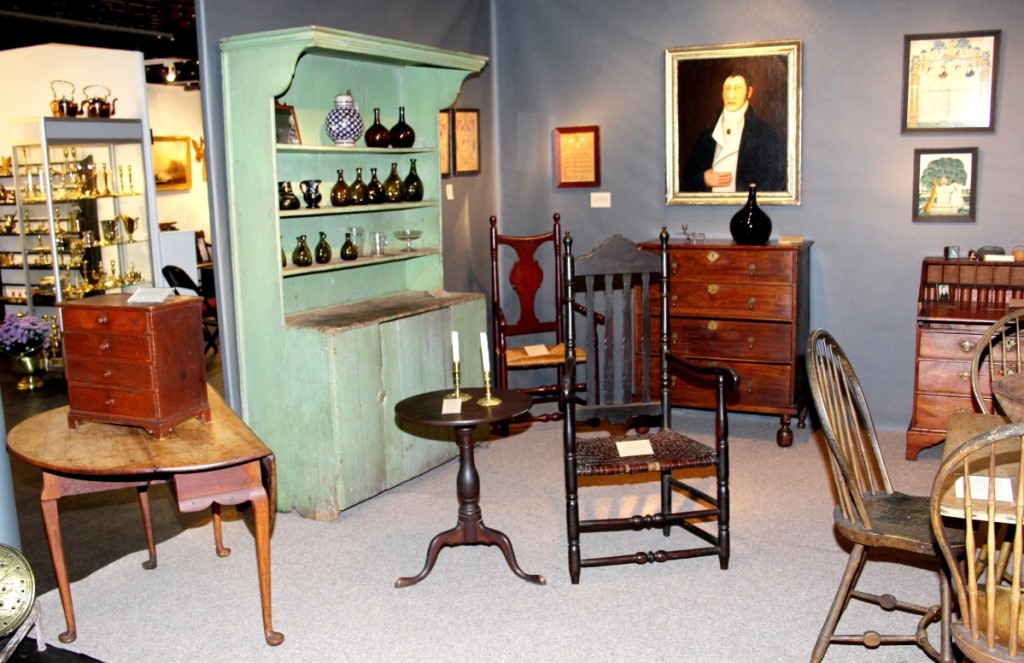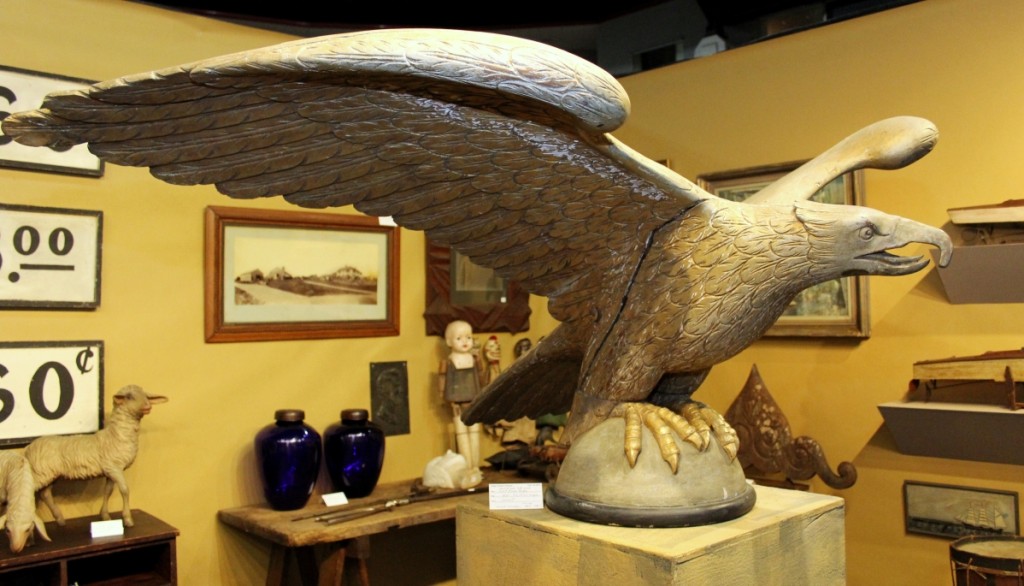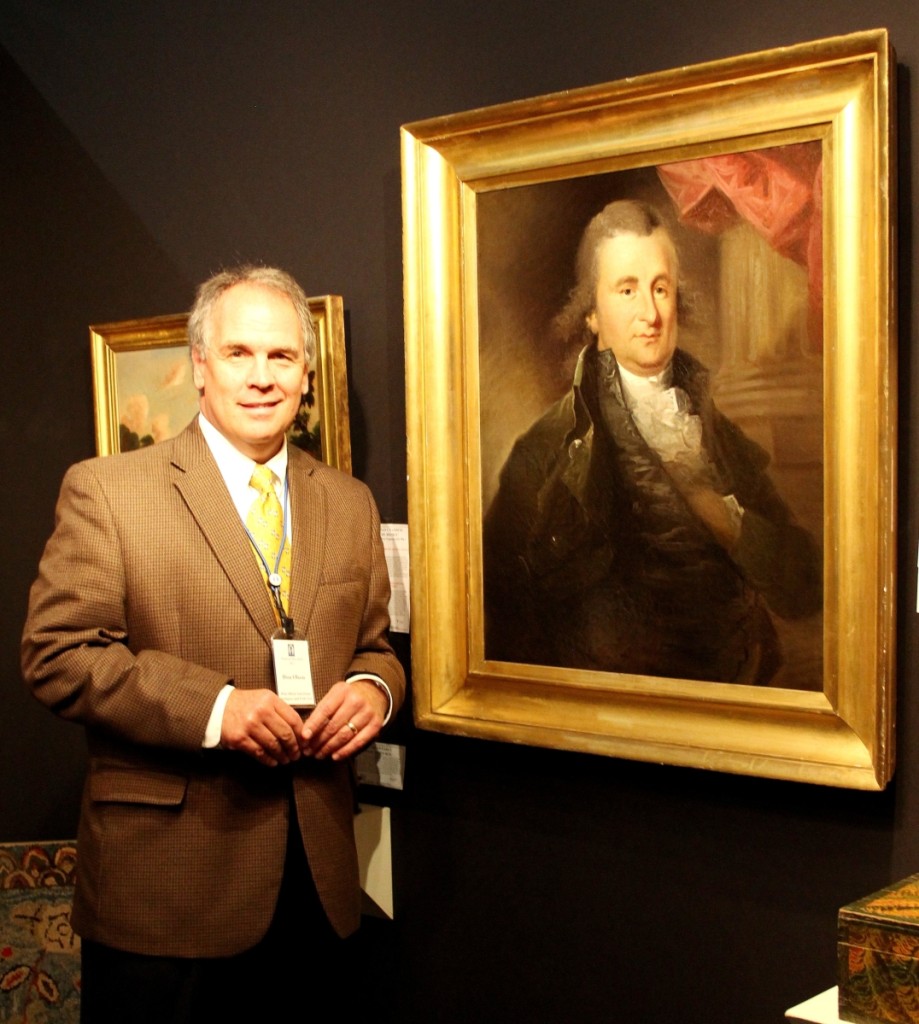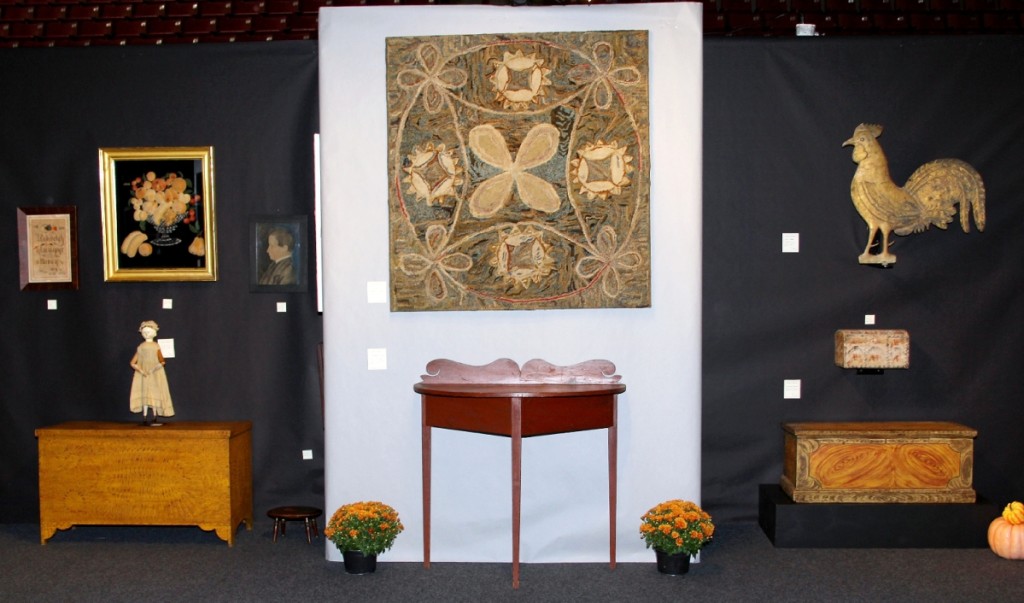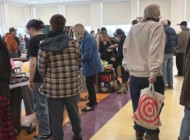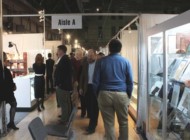Review and Photos by Laura Beach
AMHERST, MASS. – The partnership between the Antique Dealers Association of America (ADA) and Historic Deerfield is a match made in antiquarian heaven. Deerfield’s iconic “Street” was born of the enthusiasms of collectors Henry and Helen Flynt. Along it, old houses and period furnishings live in wedded bliss. With identities so intertwined, disentangling the ADA/Historic Deerfield Antiques Show from the village itself was certain to be painful.
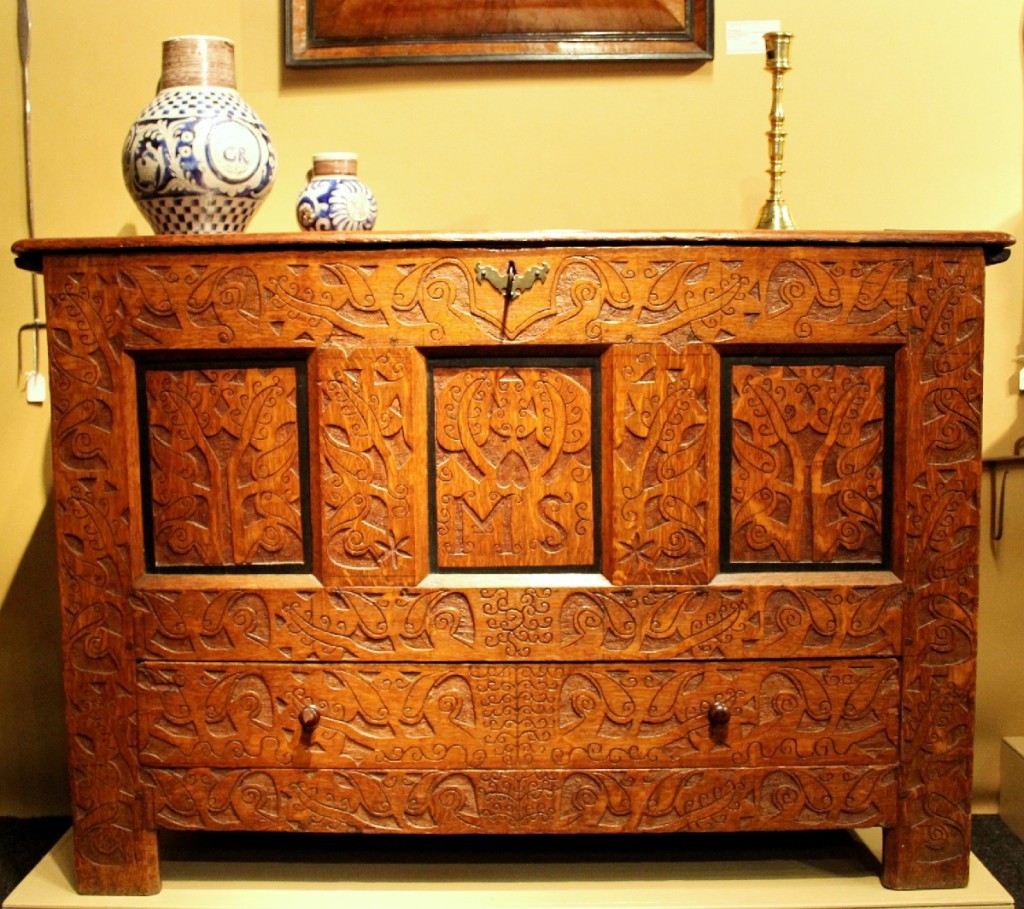
This was the first time we recall seeing a Hadley chest, the quintessential Deerfield-area furniture form, at the ADA/Historic Deerfield Antiques Show. It sold at Elliott and Grace Snyder Antiques. Unrecorded and fresh to the market, it is initialed “MS,” retains its original lid and dates to circa 1700–10.
Forced to decamp, at least temporarily, from Deerfield while Deerfield Academy revamps it athletic complex, the ADA/Historic Deerfield Antiques Show alighted at the Mullins Center at the University of Massachusetts, Amherst. The facility has much to recommend it. It is large, though perhaps too large for objects to look their best, and on one level, making set-up and pack-out easier for dealers. Onsite parking and nearby hotels and restaurants are plentiful. For this show built atop an ice rink, manager Karen DiSaia crafted an attractive floorplan, one with a central court ringed by some of the field’s most prominent Americana specialists. The setting lacks Deerfield’s postcard-perfect ambience, a problem for a small show marketing itself as a weekend destination. The temporary floor UMass put down over the ice was imperfect, causing puddles to form around the floor’s perimeter, a vexing, though not insurmountable, problem for dealers.
That said, the ADA/Historic Deerfield Antiques Show, staged over Columbus Day weekend, October 7 and 8, remains a treasure, a place where early New England artifacts of beauty and transcendent meaning regularly surface. In that and other ways its founding premise has succeeded. One well-groomed New Hampshire couple we met in the cafe told us that staying at the Deerfield Inn and shopping the show has become an annual diversion for them, their enjoyment prompting them to become Historic Deerfield benefactors.
“We are looking at other venue options for next year, even though many exhibitors liked the facility enough to go back,” said Karen DiSaia, who urges ADA members to get more involved in the search.
Arts of the Connecticut River Valley, which stretches from Canada to Long Island Sound and divides Vermont from New Hampshire, are a feature of the show. One of the region’s quintessential furniture forms, a Hadley chest, promptly sold in the booth of South Egremont, Mass., dealers Elliott and Grace Snyder. Made of carved and painted oak and pine, and dating to roughly 1700-10, the unrecorded chest turned up in a condominium in southern Maine recently and sold to the Snyders through an intermediary. The one-drawer chest, though lacking its painted surface, retains its original lid. The initials “MS” are carved below an inverted heart in the central panel of its case.
“We had an incredible show,” said Grace Snyder, rattling off a list of 31 sales, including a Queen Anne table, a blue blanket chest, early candlesticks, German stoneware, delft pottery, sconces, a snuffbox, a basket and embroidery. “We’ve been getting more interested in the Sixteenth Century and had a lot of good European things this time. You never know what there is a market for until you have it.”
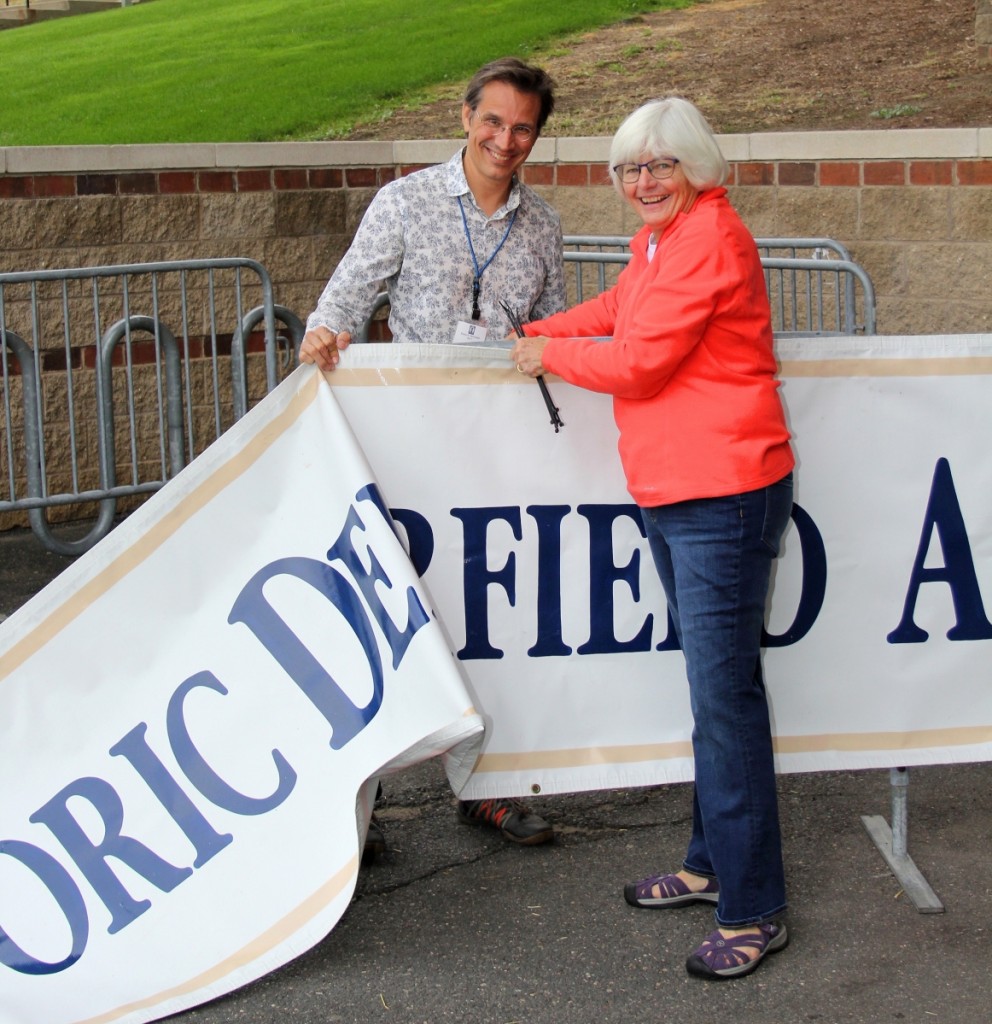
ADA president Steve Powers and show manager Karen DiSaia attended to last-minute details, such as hanging up the ADA Historic Deerfield Antiques Show banner.
The show’s only New Jersey dealers, Ron and Joyce Bassin of A Bird In Hand, are talented in the art of display. They used their ample space well, mounting focused presentations of Grenfell weaving and related objects, decoys and marine art. Among their sales was a 1903 oil on canvas ship’s portrait of the brig Forest Belle, built in Maine in 1877, along with miniature carvings by Crowell and Blackstone.
“We are the biggest, also the only, Grenfell specialists in the world,” Ron said with a laugh, describing the couple’s success with the Labrador-made rugs and mats that typically depict puffins, geese, Inuit people, sled dogs and other symbols of Canada’s north.
Against a dramatic black backdrop, Jewett-Berdan Antiques showed painted furniture and boxes, shirred and hooked rugs, theorems and other folk art. In old red paint, a folky three-legged pier table with a triangular base, semicircular top and scrolled crest was an early sale for the Maine dealers. Above it hung a Maine hooked rug in a limpid palette and, adjacent, a Jewel rooster weathervane, circa 1850, in original surface.
“The show turned out well for us,” said Tom Jewett, enumerating sales to established customers, including a couple from Pennsylvania, as well as to a few newcomers.
With newcomers in mind, several exhibitors brought material meant to appeal to campus audiences. At Nathan Liverant and Son, a 1961 “Stop H Bomb Tests” poster by Ben Shahn hung near a Federal cherry chest of drawers with undisturbed surface and a pair of choice Chapin School ribbon-back side chairs. The chairs, which retain their original leather upholstery and brass tacking, were made near Hartford, Conn., between 1780 and 1800. Liverant’s greatest rarity may have been a small gold pin made for Army private Julius Lord of Pennsylvania. It enclosed a bean from the notorious Andersonville Confederate prisoner-of-war camp in Georgia.
Newbury, Mass., dealer Peter Eaton arrayed an appealing assortment of New England furniture in undisturbed surfaces, his handsome display off the show’s center court ranging from a New Hampshire shoe-foot hutch table with a scrubbed, three-board pine top to a pewter cupboard, found in Vermont, in delectable apple-green paint.
Primitive paintings specialist Joan Brownstein, who usually exhibits with her husband, Peter Eaton, instead took her own booth, where she featured Twentieth Century pottery by Scheier and Brother Thomas, furniture by L. Meher and Vladimir Kagan, lighting by Noguchi, and paintings and posters by Richard Diebenkorn, Andy Warhol and others. Brownstein noted, “I have lots of customers for the pottery, and visitors really liked the furniture.”
“It had been several years since we did the ADA/Historic Deerfield Antiques Show and we were happy to be there,” said Barbara Adams. The Cape Cod dealer and her husband, Charles, wrote up small furniture, nautical items and documents, plus several pieces of Bennington pottery, their specialty. In their showcase, a first-edition copy of The Ashley Book of Knots, the subject of a major exhibition currently at the New Bedford Whaling Museum, prompted Charlie to remark that he has long bought everything he could find with the provenance of the New Bedford, Mass., artist, illustrator and collector Clifford W. Ashley.
Other highlights: Steven S. Powers, Brooklyn, N.Y., showed a woolwork picture of Menands, N.Y., circa 1905. The vibrant townscape included buildings finished with windows of crushed, colored glass.
Litchfield, Conn., dealer Jeffrey Tillou presented a graphite on paper farm scene by Ohio folk artist Ferdinand Brader.
Frank Levy, a New York dealer in American furniture and accessories, showed a pair of Rhode Island Chippendale side chairs, circa 1775, with a circa 1740 South County, R.I., lift-top blanket chest from the Coggeshall Family. Nearby was a grain-painted New York chest of drawers and a terrestrial globe made by Joseph Loring of Boston, circa 1833.
Artemis Gallery of North Salem, N.Y., emphasized historical china, mainly Liverpool jugs in all sizes, pairing it with early printed textiles depicting historical events. One rarity was a textile printed with the portrait of the USS Independence, the first battle ship in the fledgling US Navy.
An outstanding selection of silk embroideries, among them two coats of arms and four memorials, starred at Stephen and Carol Huber. Several of the pieces were stitched by girls at the Misses Pattens’ School in Hartford, Conn.
For antique metalware, shoppers repaired to Whitman Antiques of Ambler, Penn., where a pair of circa 1765 New York diamond-and-flame brass andirons garnered notice.
Known for early American glass, Vermont dealers Jeff and Holly Noordsy featured choice New York and New Jersey blown examples of circa 1830-40.
Mindful of the setting, Mad River Antiques hung a Federal mirror from the family of an early president of University of Massachusetts.
Portsmouth, N.H., dealer Hollis Brodrick sold a rare American Stamp Act stamp of circa 1765-66.
Other highlights included a portrait of a mother and child attributed to Ammi Phillips, an early Eighteenth Century Hudson Valley spoon rack and an elaborate shepherd whirligig at David Good Antiques.
Stephen-Douglas Antiques sold a carved and painted red rooster, displayed on a harvest table beneath a spectacular pair of primitive New York State portraits in red and gold frames.
A flamboyantly grain-painted cupboard was a highlight at Scott Bassoff and Sandy Jacobs Antiques.
Oriental Rugs, Ltd, which beckoned shoppers with a vibrant Afshar lattice-design scatter rug of circa 1910, and Quadrifoglio offered shoppers depth of selection in Nineteenth and early Twentieth Century rugs and carpets. A highlight at the latter was a rare Senneh runner, circa 1875, on a pale blue ground with a yellow border.
Rochester, N.Y., dealer Don Olson boasted a historically significant portrait of Boston patriot Samuel Gore, painted by Christian Gullager, Newburyport, Mass., circa 1796.
“Tapestry (Ogunquit)” by Clarence K. Chatterton (1880-1973), circa 1928, hung front and center at Gleason Fine Art of Boothbay Harbor, Maine.
“New venues are difficult. There was much to attend to, but attendance was about the same as in years past,” said Karen DiSaia.
Extra space meant room for two delightful loan exhibits, one featuring unpublished photographs of Deerfield taken by Samuel Chamberlain (1895-1975) between 1936 and 1971, the other arraying contemporary work by ADA members. DiSaia explained of the latter, “Antiques dealers have other sides to their lives.”
For additional information, visit www.adadealers.com or www.historic-deerfield.org.

